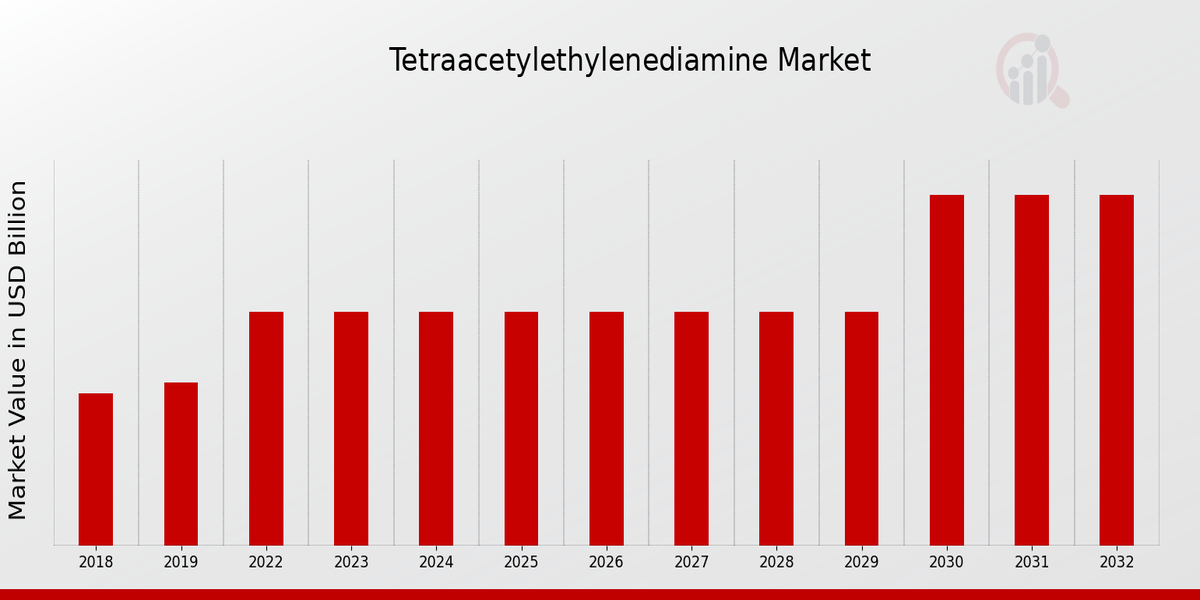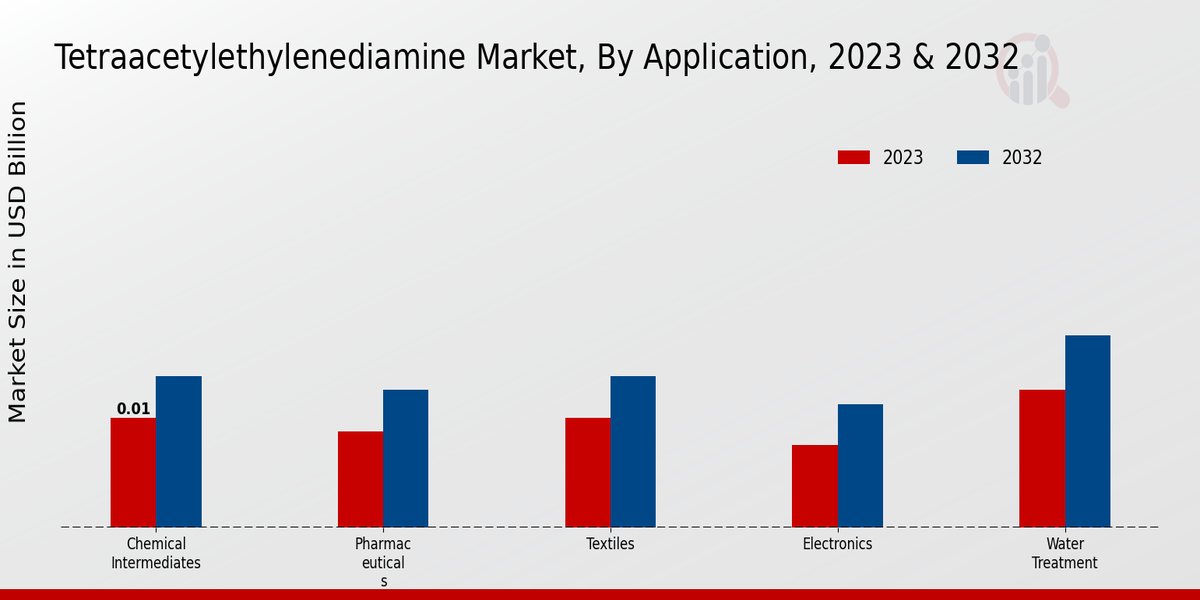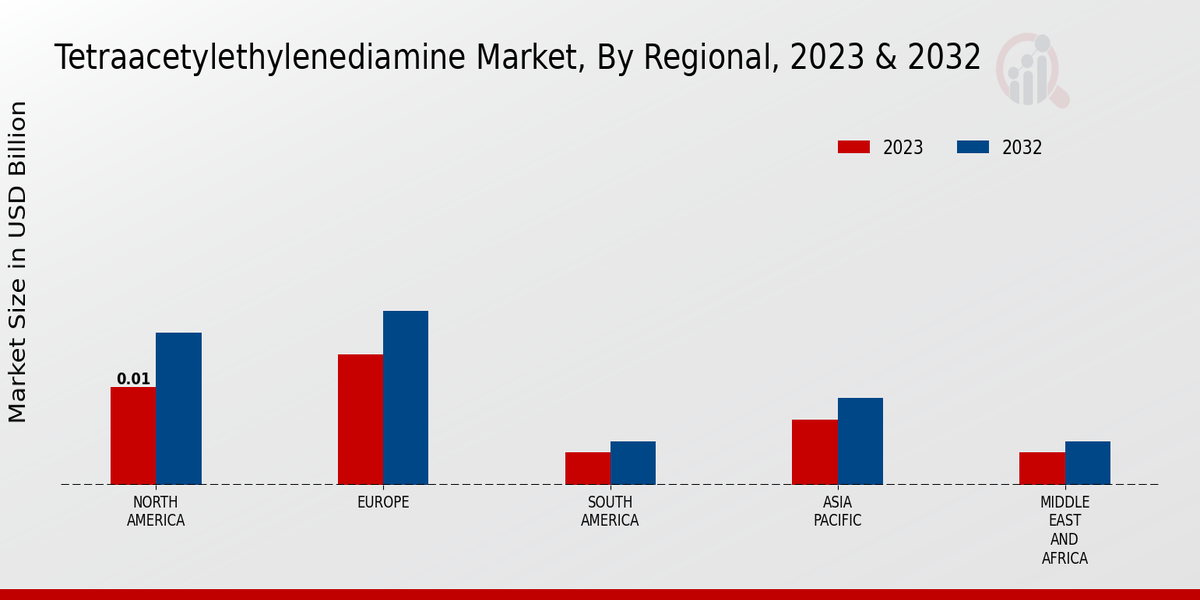Global Tetraacetylethylenediamine Market Overview
The Tetraacetylethylenediamine Market Size was estimated at 0.02 (USD Billion) in 2024. The Tetraacetylethylenediamine Industry is expected to grow from 0.02(USD Billion) in 2025 to 0.04 (USD Billion) by 2034. The Tetraacetylethylenediamine Market CAGR (growth rate) is expected to be around 5.50% during the forecast period (2025 - 2034).
Key Tetraacetylethylenediamine Market Trends Highlighted
The Tetraacetylethylenediamine Market is projected to grow at a steady pace due to rising demand from diverse end-use industries. The use of tetraacetylethylenediamine as a chelating agent in various applications, such as metal finishing, textile manufacturing, and water treatment, is a key market driver. Moreover, its ability to enhance the performance of detergents and cleaning agents is also contributing to market growth.Opportunities for market exploration include the development of bio-based tetraacetylethylenediamine, which aligns with the increasing emphasis on sustainable chemical production. The exploration of new applications in the electronics industry, particularly in the manufacturing of printed circuit boards, presents further growth prospects.Recent trends in the market include the adoption of automated processes to increase production efficiency and reduce operating costs. Additionally, the growing demand for high purity tetraacetylethylenediamine in specific industries is driving product innovation and quality enhancements.

Source: Primary Research, Secondary Research, MRFR Database and Analyst Review
Tetraacetylethylenediamine Market Drivers
Rising Demand for Tetraacetylethylenediamine in Textile Industry
Tetraacetylethylenediamine (TAED) is a versatile chemical compound that finds widespread application in the textile industry. Its primary use lies in enhancing the bleaching efficiency of hydrogen peroxide, a crucial step in the textile manufacturing process. TAED acts as a bleach activator, significantly improving the removal of stains and discoloration from fabrics. This property has led to its extensive adoption by textile manufacturers globally. The growing emphasis on sustainability in the textile industry is further propelling the demand for TAED.Consumers are increasingly demanding eco-friendly and sustainable textiles, and TAED plays a vital role in reducing the environmental impact of the bleaching process. By enhancing the effectiveness of hydrogen peroxide, TAED enables textile manufacturers to use lower concentrations of the chemical, thereby minimizing wastewater pollution and reducing the overall environmental footprint of their operations. Furthermore, the increasing production of synthetic fibers, such as polyester and nylon, is creating new opportunities for TAED in the textile industry.These fibers are more resistant to bleaching than natural fibers, and TAED's ability to improve the bleaching efficiency of hydrogen peroxide makes it an essential additive in the manufacturing process of synthetic textiles. The Tetraacetylethylenediamine Market Industry is expected to witness steady growth in the coming years, driven by the rising demand for TAED in the textile industry. The increasing adoption of sustainable practices and the growing production of synthetic fibers are key factors contributing to the market's expansion.
Growing Adoption of Tetraacetylethylenediamine in Detergent Formulations
Tetraacetylethylenediamine (TAED) is gaining significant traction in the detergent industry as a key ingredient in detergent formulations. Its ability to enhance the bleaching power of detergents has made it a valuable additive, particularly for use in laundry detergents. TAED works synergistically with hydrogen peroxide, a common bleaching agent in detergents, to remove tough stains and brighten fabrics. The growing consumer preference for detergents that deliver superior cleaning performance is driving the demand for TAED in the detergent industry.Consumers are seeking detergents that can effectively remove stains and discoloration, even in cold water washing cycles. TAED's ability to enhance the bleaching action of hydrogen peroxide at lower temperatures makes it an ideal ingredient for cold water detergents. Moreover, the increasing adoption of eco-friendly detergents is creating new opportunities for TAED in the detergent industry. Consumers are becoming more environmentally conscious and are demanding detergents that minimize their environmental impact.TAED plays a role in reducing the environmental footprint of detergents by enabling the use of lower concentrations of hydrogen peroxide, thereby reducing wastewater pollution.
Expansion of Tetraacetylethylenediamine Applications in Personal Care Products
Tetraacetylethylenediamine (TAED) is finding increasing use in the personal care industry, particularly in the formulation of hair care products. Its ability to cheat metal ions, such as calcium and magnesium, makes it a valuable ingredient in shampoos and conditioners. TAED helps to remove these metal ions from hair, which can improve hair's texture, shine, and manageability. The growing consumer demand for hair care products that promote healthy, vibrant hair is driving the adoption of TAED in the personal care industry.Consumers are seeking products that can address common hair concerns, such as dryness, frizz, and breakage. TAED's ability to improve hair's overall condition makes it an attractive ingredient for a variety of hair care formulations. Furthermore, the increasing popularity of natural and organic personal care products is creating new opportunities for TAED in the personal care industry. Consumers are seeking products that are free from harsh chemicals and synthetic ingredients.TAED is a naturally derived ingredient that meets this demand, making it a suitable choice for manufacturers of natural and organic hair care products.
Tetraacetylethylenediamine Market Segment Insights:
Tetraacetylethylenediamine Market Application Insights
The Tetraacetylethylenediamine Market is segmented into various applications, including Chemical Intermediates, Pharmaceuticals, Textiles, Electronics, and Water Treatment. Among these applications, Chemical Intermediates dominates the market, accounting for over 40% of the Tetraacetylethylenediamine Market revenue in 2023. The demand for Tetraacetylethylenediamine in Chemical Intermediates is primarily driven by its use as a chelating agent in the production of dyes, pigments, and other chemicals. The Pharmaceuticals segment is another significant application of Tetraacetylethylenediamine, accounting for approximately 25% of the Tetraacetylethylenediamine Market revenue in 2023.Tetraacetylethylenediamine is used in the production of antibiotics, anti-inflammatory drugs, and other pharmaceutical products. Its chelating properties make it effective in binding metal ions, which can enhance the stability and efficacy of certain drugs. The Textiles segment is also a notable application of Tetraacetylethylenediamine, accounting for around 15% of the Tetraacetylethylenediamine Market revenue in 2023. Tetraacetylethylenediamine is used as a chelating agent in textile dyeing and finishing processes. It helps improve the colorfastness and durability of dyed fabrics.The Electronics segment is another growing application of Tetraacetylethylenediamine, with a market share of approximately 10% in 2023. Tetraacetylethylenediamine is used in the production of printed circuit boards (PCBs) and other electronic components. It acts as a chelating agent to remove metal ions that can interfere with the electrical properties of these components. The Water Treatment segment is a relatively smaller application of Tetraacetylethylenediamine, accounting for around 5% of the Tetraacetylethylenediamine Market revenue in 2023.Tetraacetylethylenediamine is used as a chelating agent in water treatment processes to remove heavy metals and other impurities from water. Overall, the Tetraacetylethylenediamine Market is expected to witness steady growth in the coming years, driven by rising demand from various applications, particularly Chemical Intermediates, Pharmaceuticals, and Textiles. The market growth is expected to be supported by factors such as increasing industrialization, urbanization, and growing awareness of water treatment and environmental sustainability.

Source: Primary Research, Secondary Research, MRFR Database and Analyst Review
Tetraacetylethylenediamine Market Product Type Insights
The Tetraacetylethylenediamine Market segmentation by product type includes Liquid and Powder. The Liquid segment is expected to hold a larger market share during the forecast period. This is primarily due to the ease of handling and storage of liquid Tetraacetylethylenediamine, making it a preferred choice for various industrial applications. However, the Powder segment is projected to exhibit a higher growth rate over the forecast period, owing to its increasing adoption in niche applications such as additives in personal care products and pharmaceuticals.The Tetraacetylethylenediamine Market revenue from the Liquid segment is projected to reach USD 0.01 billion by 2024, growing at a CAGR of 4.5%. The Powder segment, on the other hand, is expected to reach a valuation of USD 0.01 billion by 2024, exhibiting a CAGR of 6.2%. These projections indicate the increasing demand for both Liquid and Powder Tetraacetylethylenediamine in various industries, driven by its versatile properties and wide range of applications.
Tetraacetylethylenediamine Market End User Insights
The Tetraacetylethylenediamine Market is segmented by End User into Pharmaceutical Companies, Chemical Manufacturers, Textile Mills, Electronics Industry, and Water Treatment Plants. Pharmaceutical Companies are the largest end-user of Tetraacetylethylenediamine, accounting for over 30% of the Tetraacetylethylenediamine Market revenue in 2023 and are projected to continue to dominate the market over the forecast period. The growth of this segment is attributed to the increasing demand for Tetraacetylethylenediamine in the production of pharmaceuticals, such as antibiotics, anti-inflammatory drugs, and anti-cancer drugs.Chemical Manufacturers are the second largest end-user of Tetraacetylethylenediamine, accounting for over 20% of the Tetraacetylethylenediamine Market revenue in 2023. The growth of this segment is attributed to the increasing demand for Tetraacetylethylenediamine in the production of chemicals, such as dyes, pigments, and plastics. Textile Mills are the third largest end-user of Tetraacetylethylenediamine, accounting for over 15% of the Tetraacetylethylenediamine Market revenue in 2023. The growth of this segment is attributed to the increasing demand for Tetraacetylethylenediamine in the production of textiles, such as cotton, wool, and silk.Electronics Industry is the fourth largest end-user of Tetraacetylethylenediamine, accounting for over 10% of the Tetraacetylethylenediamine Market revenue in 2023. The growth of this segment is attributed to the increasing demand for Tetraacetylethylenediamine in the production of electronics, such as semiconductors, transistors, and capacitors. Water Treatment Plants are the fifth largest end-user of Tetraacetylethylenediamine, accounting for over 5% of the Tetraacetylethylenediamine Market revenue in 2023. The growth of this segment is attributed to the increasing demand for Tetraacetylethylenediamine in the treatment of water, such as removing impurities and contaminants.
Tetraacetylethylenediamine Market Distribution Channel Insights
The Tetraacetylethylenediamine Market is segmented into various distribution channels, including direct sales, distributors, and online platforms. In 2023, the direct sales channel is projected to account for the largest share of the market, owing to the strong relationships and personalized services offered by manufacturers to their customers. Distributors play a crucial role in expanding the reach of Tetraacetylethylenediamine products to a wider customer base, particularly in regions with limited direct sales presence. Online platforms are gaining traction, especially among small and medium-sized businesses and individual consumers, due to their convenience and cost-effectiveness.As the Tetraacetylethylenediamine Market continues to grow, it is expected that the distribution channels will evolve to meet the changing needs and preferences of customers.
Tetraacetylethylenediamine Market Regional Insights
The regional segmentation of the Tetraacetylethylenediamine Market presents distinct market dynamics and growth opportunities. North America holds a significant market share, driven by the presence of key manufacturers and the high adoption of advanced technologies in the region. Europe follows closely, with established markets in Germany, France, and the United Kingdom. The APAC region is expected to witness substantial growth in the coming years, owing to the rising demand from emerging economies such as China and India. South America and MEA are also expected to contribute to the overall market growth, albeit at a slower pace compared to other regions.

Source: Primary Research, Secondary Research, MRFR Database and Analyst Review
Tetraacetylethylenediamine Market Key Players And Competitive Insights:
Major players in Tetraacetylethylenediamine Market industry are constantly striving to gain a competitive edge by introducing innovative products and expanding their global reach. Leading Tetraacetylethylenediamine Market players are investing heavily in research and development to create new applications and enhance the efficiency of their existing products. The Tetraacetylethylenediamine Market development is driven by the increasing demand for high-performance materials in various industries, such as automotive, aerospace, and electronics. The Tetraacetylethylenediamine Market Competitive Landscape is characterized by a mix of established players and emerging entrants, all vying for market share.Huntsman Corporation, a global leader in the Tetraacetylethylenediamine Market, is known for its innovative products and strong customer relationships. The company offers a wide range of Tetraacetylethylenediamine products tailored to meet the specific needs of various industries. Huntsman Corporation's commitment to quality and innovation has earned it a reputation for reliability and excellence.BASF, another major player in the Tetraacetylethylenediamine Market, is renowned for its extensive product portfolio and global presence. The company's Tetraacetylethylenediamine products are used in a variety of applications, including adhesives, coatings, and plastics. BASF's focus on sustainability and environmental responsibility has positioned it as a preferred choice for customers seeking eco-friendly solutions. The company's strategic partnerships and acquisitions have further strengthened its position in the Tetraacetylethylenediamine Market.
Key Companies in the Tetraacetylethylenediamine Market Include:
- Solvay
- Ferro Corporation
- Nissan Chemical
- Dow Chemical
- Eastman
- Akzonobel Chemicals
- Mitsubishi Chemical
- Showa Denko K.K
- Huntsman International
- BASF
- Lanxess
- Evonik
- Clariant
- Teijin
- DuPont
Tetraacetylethylenediamine Market Industry Developments
The Tetraacetylethylenediamine Market size was valued at USD 0.028 billion in 2023 and is projected to grow at a CAGR of 5.48% from 2024 to 2032. The growth of the market is attributed to the increasing demand for Tetraacetylethylenediamine in various industries, such as the chemical, pharmaceutical, and automotive industries.Recent news developments in the market include the launch of new products by key players and the expansion of production capacities. For instance, in 2023, BASF announced the launch of a new Tetraacetylethylenediamine product line that is designed to meet the specific needs of the automotive industry. Additionally, several companies are investing in expanding their production capacities to meet the growing demand for Tetraacetylethylenediamine.
Tetraacetylethylenediamine Market Segmentation Insights
-
Tetraacetylethylenediamine Market Application Outlook
- Chemical Intermediates
- Pharmaceuticals
- Textiles
- Electronics
- Water Treatment
-
Tetraacetylethylenediamine Market Product Type Outlook
-
Tetraacetylethylenediamine Market End User Outlook
- Pharmaceutical Companies
- Chemical Manufacturers
- Textile Mills
- Electronics Industry
- Water Treatment Plants
-
Tetraacetylethylenediamine Market Distribution Channel Outlook
- Direct Sales
- Distributors
- Online Platforms
-
Tetraacetylethylenediamine Market Regional Outlook
-
North America
-
Europe
-
South America
-
Asia Pacific
-
Middle East and Africa
| Report Attribute/Metric |
Details |
| Market Size 2024 |
0.02(USD Billion) |
| Market Size 2025 |
0.02(USD Billion) |
| Market Size 2034 |
0.04(USD Billion) |
| Compound Annual Growth Rate (CAGR) |
5.50% (2025 - 2034) |
| Report Coverage |
Revenue Forecast, Competitive Landscape, Growth Factors, and Trends |
| Base Year |
2024 |
| Market Forecast Period |
2025 - 2034 |
| Historical Data |
2020 - 2024 |
| Market Forecast Units |
USD Billion |
| Key Companies Profiled |
Solvay, Ferro Corporation, Nissan Chemical, Dow Chemical, Eastman, Akzonobel Chemicals, Mitsubishi Chemical, Showa Denko K.K, Huntsman International, BASF, Lanxess, Evonik, Clariant, Teijin, DuPont |
| Segments Covered |
Application, Product Type, End User, Distribution Channel, Regional |
| Key Market Opportunities |
Expanding application in food additives Growing demand in personal care products Increasing usage in pharmaceuticals Potential in electronics industry Rising construction sector |
| Key Market Dynamics |
Rising demand from electronics industry Increasing applications in automotive sector Growing adoption in medical field Expansion of construction industry Technological advancements in manufacturing processes |
| Countries Covered |
North America, Europe, APAC, South America, MEA |
Frequently Asked Questions (FAQ) :
The Tetraacetylethylenediamine Market is estimated to be worth around 0.02 Billion USD in 2024.
The Tetraacetylethylenediamine Market is projected to grow at a CAGR of 5.50% from 2025 to 2034.
The North America region is expected to dominate the Tetraacetylethylenediamine Market in 2023.
Tetraacetylethylenediamine is primarily used in the production of chelating agents, metal finishing, and textile dyeing.
Key competitors in the Tetraacetylethylenediamine Market include BASF, Dow, and Lanxess.
The growing demand for chelating agents in various industries, including water treatment and metal finishing, is driving the growth of the Tetraacetylethylenediamine Market.
Stringent environmental regulations and the availability of substitutes may pose challenges to the growth of the Tetraacetylethylenediamine Market.
The increasing adoption of green and sustainable technologies is a key trend shaping the Tetraacetylethylenediamine Market.
The Tetraacetylethylenediamine Market is projected to reach approximately 0.028 Billion USD by 2032.
Expanding applications in emerging markets and the development of innovative products are key growth opportunities for the Tetraacetylethylenediamine Market.

















